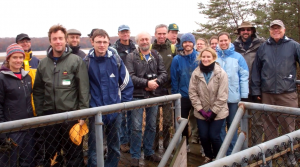16 November 2012
Over the river and through the marshes
Posted by kramsayer

An ash tree teeters on the edge as erosion eats away at the shore of a Jug Bay Wetland Sanctuary marsh. (Credit: Sean Treacy, AGU)
Upper Marlboro, Md. – Along the system of creeks throughout the Jug Bay Wetland Sanctuary, the remains of trees stuck out of the water. Others stood precariously on the edge of the shores. “That hill lost about 8 feet of land,” explained Greg Kearns, a naturalist with the U.S. Geological Survey, as he pointed at a muddy cliff and the trees that lay at the bottom in the creek. “It’s all at the bottom now, as you can see, where it collapsed.”
Seventeen ecologists and geomorphologists donned heavy gloves, coats and waterproof boots in Tuesday’s bitter cold to explore the marshes of Jug Bay Wetland Sanctuary. The 1,600-acre sanctuary, about 20 miles east of Washington, D.C., sits along Patuxent River, and is home to a broad array of wildlife, from ospreys to bald eagles. Kearns guided them through the wetlands, showing them the effects of sea level rise on its marshes.
The field trip was part of this week’s Chapman Conference on Hydrogeomorphic Feedbacks and Sea Level Rise in Tidal Freshwater River Ecosystems.

Seventeen scientists went on a field trip to Jug Bay Wetland Sanctuary in Upper Marlboro, Md., as part of the Chapman Conference on Hydrogeomorphic Feedbacks and Sea Level Rise in Tidal Freshwater River Ecosystems. (Credit: Sean Treacy, AGU)
Kearns has monitored these wetlands for 34 years. He took the scientists on a boat tour down a creek with forest land on one side and a marsh on the other, and described a landscape constantly in transition, jumping at any chance to discuss the unique qualities of the lively local environment. He summoned everyone’s attention as he spotted a red-tailed hawk flying overhead, a beaver lodge sitting in the stream, a great blue heron getting some afternoon sun, and trees that had succumbed to the erosion of the earth beneath and fallen into the stream.
The fallen trees, Kearns said, showed how sea level rise had caused the creek they were floating down to widen, he said, by about 25 to 30 feet. “One thing that I’ve noticed here, just in the 30 years that I’ve watched this marsh, is how rapidly this side in particular has eroded away,” said Kearns, pointing toward the marshy side of a creek. “There were about 15 to 20 ash trees growing right on this section about 100 yards long. Now, look, there’s not one tree left.”
“The sea level is rising and causing the channel to erode wider,” he added, “because it’s eating away at these banks and these trees are falling over.”

Andy Baldwin, a plant ecologist at the University of Maryland, discusses a sedge plant that grows at Jug Bay Wetland Sanctuary in Upper Marlboro, Md. (Credit: Sean Treacy, AGU)
Andrew Baldwin, a plant ecologist with the University of Maryland, is studying the effects of sea level rise on the elevation of Maryland’s marshes. He and his colleagues have been tracking how the Jug Bay marshes have been rising along with the sea level. Marshes usually rise along with sea level because when more water flows into the wetland, it carries more sediment with it, which adds to the muddy surface of the marshes. “These wetlands here, at least based on these measurements, are keeping pace with sea level,” said Baldwin.
Baldwin is also studying the effect an increase in saltwater would have on the marshes by adding salt to parts of the wetland and watching what happens. His research isn’t done yet, he noted, but so far it looks like the saltwater has no effect on Jug Bay’s tendency to build up.
Conservationists need to stay on top of the constantly changing environment of the wetland and preserve what they can, Kearns added. Sea level rise isn’t the only concern. Sometimes, new animals migrate into the area, and throw the ecosystem off-balance.
For example, the sanctuary is home to a vast supply of wild rice, which feed animals that live in the wetland, such as wild ducks. But in the 1990s the wild rice receded from 330 acres to about 30 acres, and Kearns was puzzled as to why.
At first, they didn’t suspect the Canada geese that had also been visiting the swamp in increasing numbers. Nobody ever saw them eating the rice. But when conservationists put fences around some of the rice, Kearns noticed the rice grew as much as 6 feet high within the fences but disappeared outside the fences. That revelation turned the geese into prime suspects. “They don’t like to fly in. They like to swim in from the edge,” said Kearns. “If you create a barrier it is really is good at creating a deterring effect.”
Kearns finally caught them in the act when he stayed out in the marshes until sunset. Hundreds of geese came from surrounding fields to feed all night on nutritious rice. The geese had evaded notice for so long by waiting until nightfall. Now the wetland is producing as much rice as it once had.
-Sean Treacy, AGU science writing intern
See further videos of Greg Kearns describing how last year’s mid-Atlantic earthquake affected the wetland and discussing efforts to clean junk that accumulates in the wetland.


 GeoSpace is a blog on Earth and space science, managed by AGU’s Public Information staff. The blog features posts by AGU writers and guest contributors on all sorts of relevant science topics, but with a focus on new research and geo and space sciences-related stories that are currently in the news.
GeoSpace is a blog on Earth and space science, managed by AGU’s Public Information staff. The blog features posts by AGU writers and guest contributors on all sorts of relevant science topics, but with a focus on new research and geo and space sciences-related stories that are currently in the news.